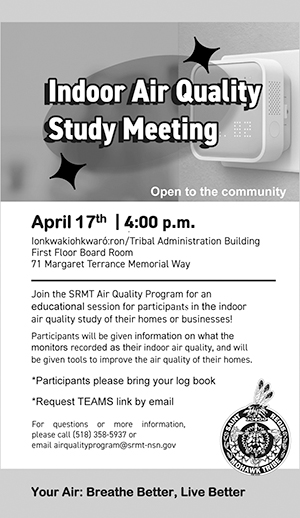The Four Winds
Reprinted from WORDS THAT COME BEFORE ALL ELSE
Environmental Philosophies of the Haudenosaunee
Continued from Vol. 29 #49
SECTION II: WHY THE FOUR WINDS ARE HAVING PROBLEMS
The Four Winds are in trouble because human kind has lost respect for the power of the Four Winds and forgotten their importance to all life. The standard of living that is expected by industrial societies and their associated material goods have been traded for clean, unpolluted air. In trade for refreshing breaths are toxic materials which are the by-products of the production of electricity to power our possessions and of the things we feel we must possess. Consumer society has altered peoples mind to believe that quality of life is possessing many things. Consumer based societies demand machinery, appliances, automobiles, fuel, and all at a low price. Unfortunately, the low price has a hidden cost that is taxing the ability of the Four Winds to refresh our lands.
The Four Winds are in trouble because of the heavy industrialization that began in the mid 1800’s and that is continuing today. Industry, the products of industry and the use of the products of industry have placed a heavy burden on the air we breathe. The industrial age began with no regard for Mother Earth and her elements. The furnaces of industry belched iron and steel, and great riches, for the powerful magnates of the industrial age.
Only recently has there been concern, mainly because the effects on humans, primarily because of the revelation that something is happening to the Four Winds and is happening fast. In the past century, the industrial and consumer society has had a profound impact upon the atmosphere. The impacts are of global proportions and affect every being on Mother Earth. Industrial nations are urgently trying to resolve global warming and depletion of the ozone layer through international agreements. These measures, however, are deeply criticized for not going far enough or not being significant enough to achieve any real progress. Industrial economists are concerned that reducing consumption of resources such as oil and gas, a source of carbon dioxide (green house gas), will result in the loss of thousands of jobs and severe impacts to the national economy. Apparently, they haven’t thought much about who they would be selling fuel and gas to when environmental impacts begin to eliminate human life. One such agreement is the 1997 Kyoto Agreement, which is intended to reduce emissions of “green house gases” worldwide by industrial nations.
A December 14, 1997 Washington Post article titled “In the Spirit of Kyoto,” highlights United States Vice-President Al Gore’s remarks concerning the Kyoto agreement.
“Because of our new technological power and our growing numbers, we now must pay careful attention to the consequences of what we are doing to the Earth, especially to the atmosphere.
The most vulnerable part of the Earth’s environment is the very thin layer of air clinging near to the surface of the planet, which we are now so carelessly filling with gaseous wastes that are actually altering the relationship between the Earth and the sun by trapping more solar radiation under this growing blanket of pollution that envelopes the entire world. The extra heat that cannot escape is beginning to change the global patterns of climate to which we are accustomed and to which we have adapted over the past 10,000 years.
Last week, we learned from scientists that this year, 1997, will be the hottest since records have been kept. Indeed, 9 out of the 10 hottest years since the measurements began have come in the past decade. The trend is clear. The human consequences and the economic costs of failing to act are unthinkable: more record floods, droughts. Diseases and pests spreading to new areas. Crop failures and famines. Melting glaciers, stronger storms, and rising seas.
Our fundamental challenge is to find out whether and how we can change the behaviors that are causing the problem. We all understand that our work in Kyoto is only a beginning. None of the proposals being debated here will solve the problem completely by itself. But, if we get off to the right start here, we can quickly build momentum as we learn together how to meet this challenge.
Our first step should be to set realistic and achievable, binding emissions limits, which will create markets for new technologies and new ideas that will, in turn, expand the boundaries of the possible and create new hope. Other steps will then follow. And then, ultimately, we will achieve a safe overall concentration level for green house gases in the Earth’s atmosphere. This is the step-by-step approach we took in Montreal 10 years ago to address the problem of ozone depletion. And it is working.
This time success will require that we heal the divisions among us. The first and most important task for developed countries is to hear the immediate needs of the developing world. The United States has listened and we have learned. We understand that your first priority is to lift your citizens from the poverty so many endure and to build strong economies that will ensure a better future.
And let me be clear in our answer to you. We do not want to founder on a false divide. Reducing poverty and protecting the Earth’s environment are both critical components of truly sustainable development. We want to forge a lasting partnership to achieve a better future. One key is mobilizing new investment in your countries to ensure that you have higher standards of living, with modern, clean and efficient technologies. That is what our proposals for emissions trading and joint implementation strive to do.
To our partners in the developed world, let me say we have listened and learned from you as well. For our part, the United States remains firmly committed to a strong, binding target that will reduce our own emissions by nearly 30 percent from what they would otherwise be _ a commitment as strong or stronger than any we have heard from any country. The imperative here is to do what we promise, rather than to promise what we cannot do.
All of us, of course, must reject the advice of those who ask us to believe there really is no problem at all. We know their arguments; we have heard others like them throughout history. For example, we remember the tobacco company spokesmen who insisted smoking does no harm. To those who seek to obfuscate and obstruct, we say: We will not allow you to put narrow special interests above the interests of all humankind.
So what does the United States propose that we do? The first measure of any proposal must be its environmental merit, and ours is environmentally solid and sound. It is strong and comprehensive, covering all six significant greenhouse gases. It recognizes the link between the air and the land, including both sources and sinks. It provides the tools to ensure that targets can be met. It is also economically sound. And with strict monitoring and accountability, it ensures that we will keep our bond with one another.
Today, let me add this. After talking with our negotiators this morning and after speaking on the telephone from here a short time ago with President Clinton, I am instructing our delegation right now to show increasing negotiating flexibility if a comprehensive plan can be put in place, one with realistic targets and timetables, market mechanisms and the meaningful participation of key developing countries.
Earlier this century, the Scottish mountain climber W. H. Murray wrote: ‘Until one is committed there is hesitancy, the chance to draw back, always ineffectiveness. Concerning all acts of initiative... there is one elementary truth, the ignorance of which kills countless ideas and splendid plans: that the moment one definitely commits oneself, providence moves, too.’
So let us press forward. Let us resolve to conduct ourselves in such a way that our children’s children will read about the “Spirit of Kyoto,” and remember well the pace and the time where humankind first chose to embark on a long-term sustainable relationship between our civilization and the Earth’s environment.”
Another agreement, the Montreal Protocol, was established to reduce the emissions of ozone depleting compounds, such as Freon used in refrigeration and as a propellant in consumer aerosol cans. The Montreal Protocol was signed in September 1987.
The Ozone Secretariat summarizes the importance of the ozone layer and how the ozone layer is being destroyed (The Ozone Secretariat is the Secretariat for the Vienna Convention for the Protection of the Ozone Layer and for the Montreal Protocol on Substances that Deplete the Ozone Layer. The Secretariat is based at the United Nations Environment Programme (UNEP) offices in Nairobi, Kenya).
“The Ozone Layer is found in the stratosphere between 10-50 km above the ground. Ozone molecules have three atoms of oxygen instead of the normal two. The Ozone Layer protects us from the harmful effects of certain wavelengths of ultraviolet (UV) light from the sun, specifically UV-B. Any significant decrease in ozone in the stratosphere would result in an increase of UV-B radiation reaching the earth surface.
Increases in levels of UV-B radiation can result in the increase in skin cancers, suppress the immune system, exacerbate eye disorders including cataracts and affect plants, animals, and plastic materials.
Chlorofluorocarbons (CFCs) invented in1928 found many uses in aerosols, foam refrigeration, air conditioners, solvents, fire extinguishers, etc. These CFCs are long lived, their emissions reach the stratosphere and cause ozone depletion. This ozone depletion has been dramatically confirmed trough the Antarctic “Ozone Hole” discovered in 1985 and observations, since then. of ozone depletion in the middle and higher latitudes.”
The United Nations Environment Programme (UNEP) has been addressing this issue since 1977. Under the auspices of UNEP, the governments of the world arrived at the Vienna Convention on the Protection of the Ozone Layer in 1985. Through this Convention, governments committed themselves to protect the ozone layer and to co-operate with each other in scientific research to improve understanding of the atmospheric processes.
The Montreal Protocol on Substances that Deplete the Ozone Layer was agreed to by governments in 1987 and has been Amended three times so far, in London in 1990, in Copenhagen in 1992 and recently, in Montreal in 1997. The Protocol aims to reduce and eventually eliminate the emissions of man-made ozone depleting substances.
The list of countries which are Party to the Convention, the Protocol and the Amendments of the Protocol, as well as information on the ratification dates, are detailed in the Status of Ratification. The Parties have agreed on Rules of Procedure which apply to any meeting of the Parties to the Montreal Protocol and of the Conference of the Parties to the Vienna Convention.
A depository notification concerning the Montreal Adjustments and the Amendment, which were adopted by the Parties on 17 September 1997 at their Ninth Meeting in Montreal, was transmitted by the Secretary General of the United Nations to all Parties, on December 1997.









Reader Comments(0)